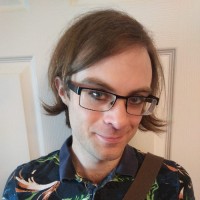
Brent W. Barker
- Courses1
- Reviews1
- School: Roosevelt University
- Campus:
- Department: Physics
- Email address: Join to see
- Phone: Join to see
-
Location:
430 S Michigan Ave
Chicago, IL - 60605 - Dates at Roosevelt University: February 2018 - February 2018
- Office Hours: Join to see
Biography
Roosevelt University - Physics
Teaching Support Manager, Astrophysics at UChicago; Counseling Graduate Student; Nonviolence Practitioner
Higher Education
Brent W.
Barker
Chicago, Illinois
On a foundation of higher education, computer programming, and nuclear physics experience, adding in deep interpersonal skills and commitment to a world that works for everyone, I want to help individuals and organizations communicate with themselves and each other in ways that are more likely to lead to decisions that work for more people. This can look like advising, counseling, coaching, or training in communication, conflict management, or organization consulting.
Experience
Roosevelt University
Assistant Professor of Physics
Brent worked at Roosevelt University as a Assistant Professor of Physics
Roosevelt University
Visiting Assistant Professor of Physics
Brent worked at Roosevelt University as a Visiting Assistant Professor of Physics
American Association of Physics Teachers - Chicago Section
Past President (President Elect, President, Past President)
Brent worked at American Association of Physics Teachers - Chicago Section as a Past President (President Elect, President, Past President)
Joint Institute for Nuclear Astrophysics, Michigan State University
Research Consultant
I design and maintain computer simulations to investigate microscopic interactions and bulk properties of nuclear many-body systems. I advise the team on strengths and limitations of current simulations.
University of Chicago
Teaching Support Manager, Astrophysics and Geophysical Sciences
I manage and direct the instructional laboratory and lecture demonstration program for undergraduates in the Department of Astronomy & Astrophysics and for general education classes in the Department of Geophysical Sciences. This includes managing facilities and equipment, curriculum leadership, and TA training and supervision.
* Student Experience Committee, Dept of Astronomy & Astrophysics (2019-Present)
* Equity and Inclusion Council, Dept of Astronomy & Astrophysics (2018-Present)
* Stone Edge Observatory Committee, Department of Astronomy & Astrophysics (2018-Present)
* Committee on Managing the Deluge of Undergraduates, Physical Sciences Division (2019)
* Physical Science Teaching Prize Committee (2019)
* Undergraduate Committee, Department of Astronomy & Astrophysics (2018-2019)
* Staff Working Group for Equity, Diversity, and Inclusion, Physical Sciences Division (Facilitator, 2018)
* LGBTQ Safe Space Training (2018)
* Trained Facilitator for Hearing One Another workshops (2018)National Superconducting Cyclotron Laboratory, Michigan State University
Research Assistant
Conducted independent research on transport properties of many-particle quantum systems. Developed computer software for numerical modeling. Participated in international research collaborations. Presented research at national and international conferences.
Education
Michigan State University
Doctor of Philosophy (Ph.D.)
Theoretical Nuclear Physics
Michigan State University
Master of Science (M.S.)
Physics
Roosevelt University
Master of Arts - MA
Clinical Mental Health Counseling
Roosevelt University
Assistant Professor of Physics
Roosevelt University
Visiting Assistant Professor of Physics
Publications
Shear viscosity from nuclear stopping
Physical Review C
Within a Boltzmann transport model, we demonstrate correlation between stopping observables and shear viscosity in central nuclear collisions at intermediate energies (on the order of 10–1000 MeV/nucleon). The correlation allows us to assess the viscosity of nuclear matter, by tuning the in-medium nucleon-nucleon cross section in our transport model to agree with nuclear stopping data. We also calculate the ratio of shear viscosity to entropy density to determine how close the system is to the universal quantum lower limit proposed in the context of ultrarelativistic heavy-ion collisions.
